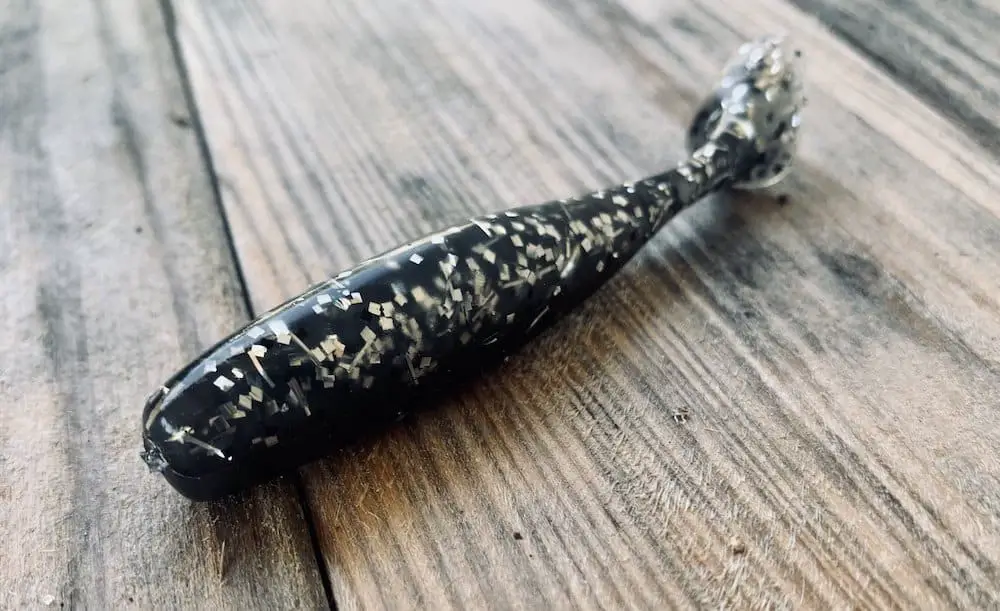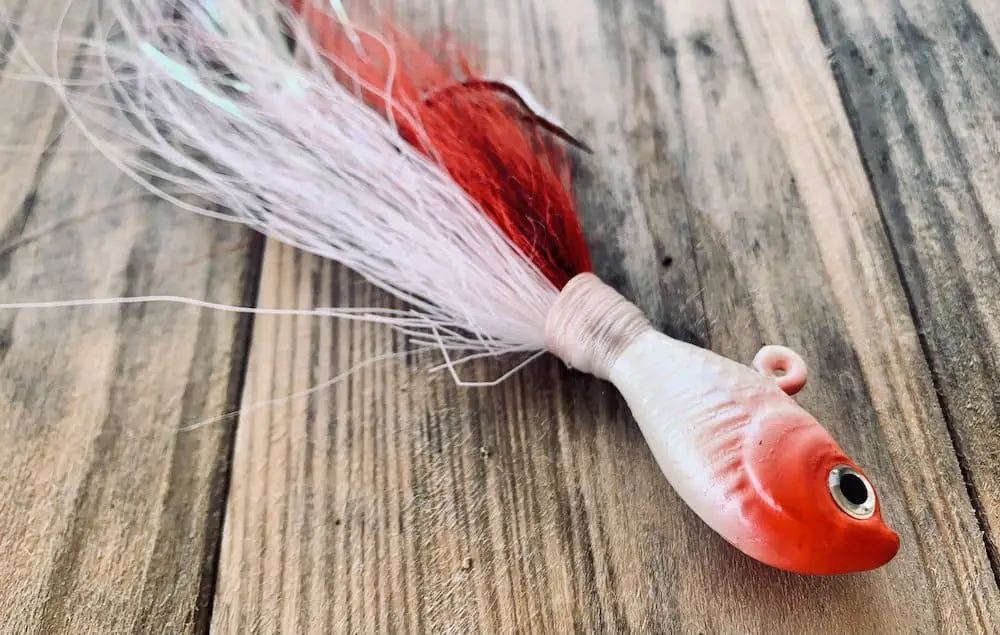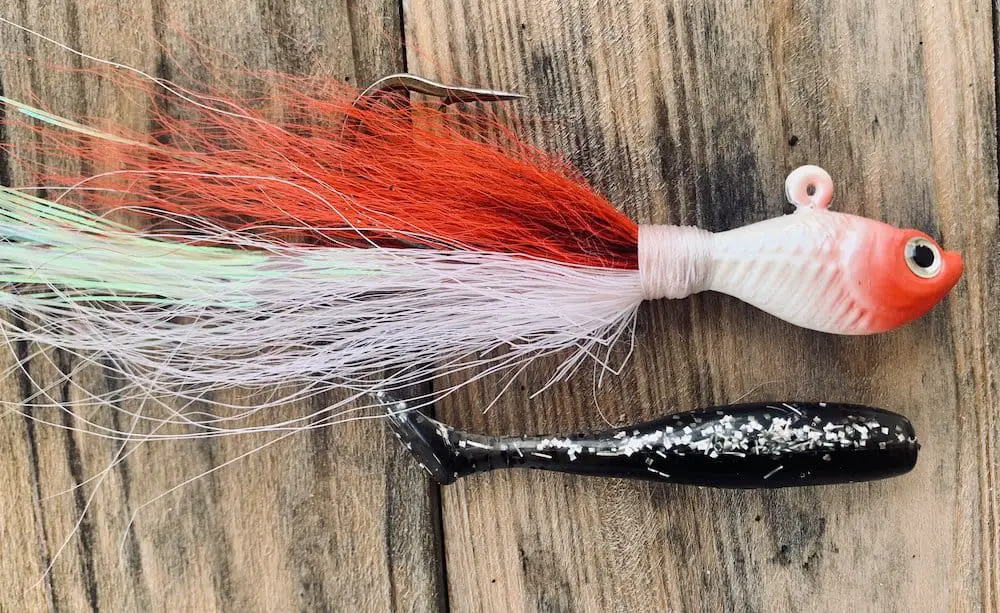Anglers frequently fish with jigs for bass and other freshwater species. Jigs heads will be paired with soft plastic tails or feather skirts to entice bites around structure. With a tackle box full of jig heads, anglers new to saltwater often wonder if jigs work in saltwater. Jigs work well in saltwater, especially when targeting bottom dwelling species such as grouper, flounder, or sheepshead. Jig heads with tails mimic the look and behavior of shrimp, and stand up jigs with artificial crab lures imitate crabs skirting along the sand. The various types of jigs require different techniques for the proper presentation. Read on to discover how different types of jigs can be used to target different saltwater species.
How to Work Saltwater Jigs
Saltwater jigs come in several varieties. The most common is a weighted jig head with a hook attached, which is rigged with a soft plastic body attached. The soft plastic can be a shrimp shape, or a tapered tube, a paddletail, or a spiral tail body. Depending on the style of soft plastic you choose and the fishing spot, your presentation will vary. When fishing with a jig head and soft plastic shrimp, you can imitate a live shrimp by doing a slow and steady retrieve, periodically lifting and lowering the rod tip to lift the shrimp off the bottom.
Tubes attached to jig heads produce very well when casted out and retrieved with a periodic jerk. Some of the heavy duty jig heads and tubes are even geared towards big game trolling. The taper of the jig head defines whether the jig swims straight or darts on the troll. Jig heads can be a cost effective choice when big game fishing when compared to the heavy duty crankbaits on the market. Tubes can also be replaced if a big fish bites it off.
Paddletail soft plastics are also frequently paired with jig heads in saltwater. These are my go-to jigs when fishing the flats at Mosquito lagoon or inshore in the Indian River. Jigging with paddletails is a fun way to try new jigging techniques and see what works on any given day. When jigging with paddletails, my go-to retrieve involves twitches and pauses during the retrieve. When using a soft plastic with a spiral tail, I use the same retrieve pattern.

Bucktail jigs are another very common, tried-and-true jig for saltwater fishing. A bucktail jig is a jig head with with a hook attached and teaser feathers to disguise the hook. When a bucktail jig is pulled, the feathers straighten out, and when you pause the retrieve, the feathers balloon out. Retrieving with a consistent pause attracts fish with the moving colors. Bucktail jigs are used from shore, jigging over structure offshore, and even trolled. Effectively working a jig also requires the use of a proper jigging rod. Read my article Top 7 Jigging Rods for tips on choosing the best rod.
I have identified my top 5 jigs for saltwater fishing below. Read more to learn about them and what colors and sizes to choose.
5 Best Jigs for Saltwater
1. RonZ Big Game Series Rigged Soft Baits
The RonZ Big Game Series Rigged Soft Baits are a great option when targeting big game. These versatile lures can be trolled, casted, and jigged. The shape of the jig head helps reduce drag on the lure, helping it maintain depth when trolled. The eyelet has a built-in swivel to allow the jig to dart back and forth with ease. The side to side motion of the jig head also moves the tube back and forth. This jig can be casted out and retrieved with rod twitches along the way. The jig will dart when you do this and will look like a baitfish. RonZ also sells replacement tails to keep on hand in case a fish bites one off.
2. Z-Man TT Lures HeadlockZ HD Hooks
The Z-Man TT Lures with HeadlockZ HD Hooks pair perfectly with the Z-man paddletails. These jigs are built with Mustad Ultrapoint heavy duty hooks to be able to withstand a strong hookset from some of the biggest fish in the ocean. The threads near the jig head do a great job at holding the soft plastic in place. The jig head has the weight engraved in it, which is really helpful when you’re looking for a particular size. When using this jig for a large fish such as a mahi, I’ll go for the 8/0 hook, and I’ll drop down to a 3/0 or 4/0 when fishing inshore.
3. Bucktail Jigs
If you’re looking to target flounder nearshore, the Spro Prime Bucktail jig my go-to. Make sure you choose a size that will drop to the bottom, and the color can be personal preference. I tend to go for white ones with some red eyes or red feathers. Bucktail jigs can also be used inshore for redfish and mangrove snapper. A faster retrieve with pauses worked in is the best way to work one of these jigs.

4. Bottom Sweeper Jigs
These bottom sweeper jigs by Insomniac Outdoors are meant for sheepshead. The hook size is very small, so it’ll fit in a sheepshead’s small mouth. These jigs are rigged with a Mustad Ultrapoint heavy duty hook so you’ll never have to worry about the hook straightening out during the hookset. The pink and white colors are my go-to and I keep a variety of sizes on hand for whatever water depth I’m fishing. Bottom sweeper jigs are unique because the design allows the jig to scoot across bottom without tipping over. These jigs are very effective, especially when tipped with bait.
5. Savage Gear 3D Crab Stand Up Jig Heads
When fishing inshore for redfish, or targeting black drum from shore, the Savage Gear 3D crab stand up jig head paired with the Savage Gear 3D crab becomes a unique, yet highly effective lure choice. The jig is the weight the keeps the crab in the horizontal position in the water and lets it slide across the bottom when retrieved. I always have these on hand to try out when the fish aren’t biting my usual jigs. These jig heads are conveniently sold in a 2 or 3 pack.
There are also speed jigs and slow pitch jigs that are used in saltwater. To read about these types of saltwater jigs, see my article Slow Jigging & Fast Jigging: Is Speed the Only Difference?

